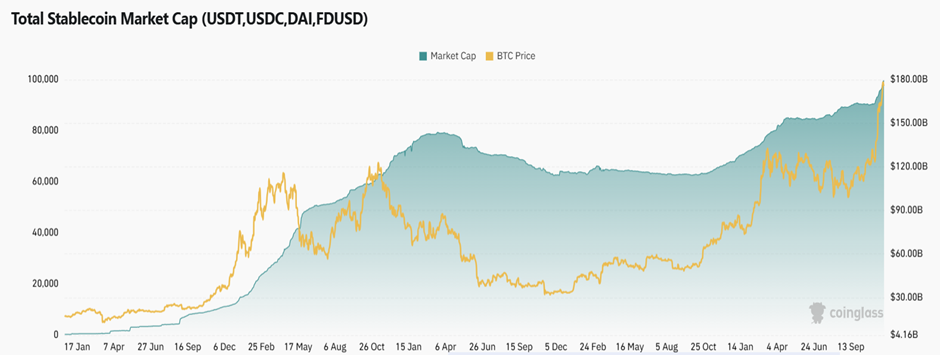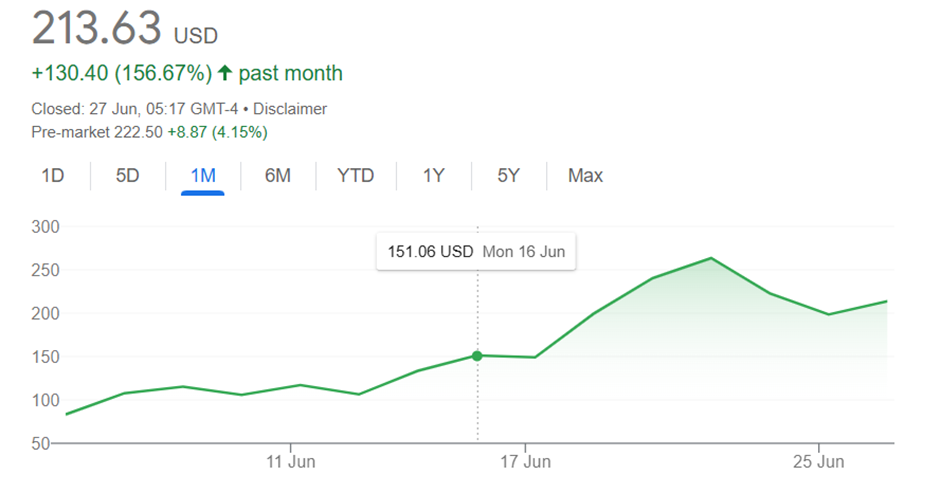Here’s why Citi says crypto prices have been weak recently
Circle’s (NYSE:CRCL) rapid rise as a stablecoin issuer, highlighted by a record-breaking IPO and expanding institutional adoption, mirrors a broader shift toward regulated digital finance. The GENIUS Act, passed in June 2025, reinforces this momentum by introducing strict standards for transparency, reserves, and consumer protection, positioning stablecoins as core components of the future financial system.
Introduction
In recent years, stablecoins have become one of the fastest-expanding sectors in digital finance, surpassing $238 billion in circulating value by mid-2025. As cryptocurrencies faced volatility and scepticism, stablecoins offered a bridge to fiat currencies, unlocking new possibilities in payments, remittances, and decentralised finance.
At the heart of this transformation stands Circle Internet Group, issuer of USD Coin (USDC), now a major player in global payments infrastructure. As stablecoins gain prominence, USUS lawmakers introduced the bipartisan GENIUS Act, aiming to bring regulatory clarity through strict reserve requirements, transparency, and oversight.
Circle’s rapid ascent and the sweeping regulatory shift introduced by the GENIUS Act signal a pivotal moment that could reshape the stablecoin landscape for years to come.
Circle Internet Group: Leading the Stablecoin Revolution
Founded in 2013 by Jeremy Allaire and Sean Neville, Circle initially focused on peer-to-peer payments before fully pivoting to stablecoins, recognising their transformative potential in global finance. Today, USDC ranks as the second-largest dollar-backed stablecoin globally, with a market share of around 30%, posing as the main competitor with industry leader Tether (USDT).
Circle’s ability to integrate with legacy financial systems and offer scalable, enterprise-grade infrastructure has helped it secure attention from institutional partners and traditional payment networks, enabling expansion well beyond the crypto-native environment.

The company’s IPO on June 5, 2025, marked a historic milestone for the stablecoin sector as it is the most explosive IPO for any USUS company raising $500 million or more since 1980. Priced at $31 per share, Circle’s stock soared to around $270 within days, briefly pushing its market capitalisation close to $60 billion.
The Senate’s passage of the GENIUS Act just days after Circle’s IPO added further momentum, signalling that USUS regulators were moving toward providing the legal clarity long sought by stablecoin issuers and their investors. Analysts at Seaport Global highlighted Circle as a "top-tier crypto disruptor," projecting 25% to 30% annual revenue growth for Circle, and the stablecoin market capitaliSation potentially reaching $2 trillion over the long-term, from roughly $240 billion today.

Part of the optimism around Circle stems from its success in positioning USDC as more than just a crypto trading tool. Through partnerships with traditional payment processors like Fiserv (NYSE:FI), Circle is developing stablecoin-enabled solutions for financial institutions and merchants.
This collaboration will integrate Circle’s platform with Fiserv’s digital banking and payments infrastructure to expand global access to digital dollars and improve payment experiences. Shopify (NASDAQ:SHOP) has already announced plans to support USDC payments by the end of 2025. Meanwhile, Amazon (NASDAQ:AMZN) and Walmart (NYSE:WMT) are reportedly testing stablecoin-based systems for loyalty programmes and digital checkouts.
If these pilots scale, USDC could emerge as a core infrastructure for next-gen payments, reducing transaction costs, enabling instant cross-border settlements, and introducing programmable money into corporate finance. Early pilots with multinational retailers suggest stablecoins could save billions in annual credit card fees while enhancing operational efficiency.
Moreover, Circle’s aggressive expansion strategy includes courting the corporate treasury market, where stablecoins could play a role in liquidity management, supply chain finance, and yield optimisation. With programmable smart contracts, corporates can automate complex financial transactions, reduce reconciliation delays, and improve capital efficiency.
This convergence of stablecoins and tokenised real-world assets is also fuelling Circle’s efforts to serve corporate treasury functions, providing new tools for liquidity management, automated payouts, and cross-border capital flows in a globalised economy.
Yet not all market observers share the same enthusiasm. While some remain bullish, other analysts have expressed caution. Compass Point’s Ed Engel, for instance, placed a neutral rating on Circle shortly after its IPO rally, warning that the stock was trading nearly 20% above fair value. He set a price target of $205, significantly below Circle’s post-rally highs, citing valuation concerns, most notably forward earnings multiple nearing 180x compared to an S&P 500 average of around 22x. Such lofty multiples reflect enormous investor expectations for both revenue growth and eventual market dominance.
Indeed, some institutional investors have begun trimming positions. Cathie Wood’s ARK Investment Management notably sold a portion of its Circle holdings, causing the stock to pull back roughly 7.7%, signalling wariness about short-term overvaluation.
Despite these cautionary moves, broader institutional interest remains robust, fuelled by the possibility that stablecoins, under a clear regulatory framework, may soon integrate into the core of global payment networks. BlackRock (NYSE:BLK), Fidelity, and several sovereign wealth funds have all reportedly taken stakes in Circle, betting on its long-term growth story.
Circle’s growth also raises important questions about its role in broader financial markets. According to a June 2025 Reuters report, approximately 80% of the $256 billion stablecoin market is already allocated to US Treasury bills and repurchase agreements, representing around $200 billion in demand for short-term government debt.
As Circle issues more USDC to meet payment and liquidity demand, it must hold a matching amount in safe, liquid reserves, primarily short-term Treasuries, thus becoming an increasingly influential buyer in the sovereign debt market. As stablecoins like USDC grow, their consistent purchases of short-dated Treasuries help absorb supply.
However, this also creates potential vulnerabilities: a sudden contraction in stablecoin circulation, could trigger unexpected volatility in Treasury markets.
The GENIUS Act: Regulatory Clarity and the Future of Stablecoins
The bipartisan GENIUS Act, short for “Guaranteed and Enforceable Neutrality in Issuance and Use of Stablecoins,” represents the most ambitious federal effort to date to regulate stablecoins. Passed by the US Senate in June 2025, the legislation aims to bring legal clarity, financial stability, and consumer protection to an industry that has rapidly scaled without uniform oversight.
The bill creates a foundational framework to legitimise stablecoins as integral components of the USUS payments system, while aiming to prevent systemic vulnerabilities seen in past failures like with Terra-Luna.
To ensure that stablecoins maintain a stable value, the Act mandates full 1:1 backing in US dollars or equivalent highly liquid assets and requires issuers to publish monthly reserve disclosures alongside annual third-party audits. This introduces a new level of transparency and accountability to an industry that, until now, has operated with broad discretion and limited regulatory oversight.
By requiring strict transparency and reserve backing, the Act aims to prevent crises akin to the Terra-Luna collapse of 2022, where opaque reserves and flawed design led to a $60 billion market wipeout, thereby reinforcing market confidence and systemic resilience.
The GENIUS Act also introduces tiered oversight based on issuer size. Stablecoin issuers with over $10 billion in market cap fall under federal regulation, while smaller ones may opt for state-level oversight, if the state’s standards align with federal rules. This flexible framework fosters innovation while imposing stricter scrutiny on systemic players. It also prohibits non-financial public companies from issuing stablecoins.
Consumer protections are strong: holders can redeem tokens at par, with claims prioritised in bankruptcy. Courts must expedite redemptions, and issuers are barred from using reserve leverage or suggesting federal backing (e.g., FDIC insurance). The aim is to ensure stablecoins function like cash without exposing users to undue risk.
Internationally, the bill’s passage signals that the US is asserting leadership in setting global digital asset norms. It aligns conceptually with the European Union’s MiCA framework and requires foreign issued stablecoins seeking access to the US market to meet comparable standards.
This provision not only protects domestic consumers but also sets a benchmark that could influence how stablecoin policy develops across jurisdictions. Foreign firms wishing to serve US customers will now need to match these high thresholds or be effectively excluded.
Ultimately, the GENIUS Act transforms stablecoins from speculative crypto instruments into tightly regulated financial products. It promises to reshape how digital dollars are issued, governed, and used, ushering in an era of safer, faster, and more transparent digital payments. For investors, regulators, and innovators alike, it establishes the US as a global standard-setter in a space long marked by regulatory ambiguity.
For the Trump administration, legitimising stablecoins could help America fulfil 3 very important objectives:
First, increase the demand for US Treasury bills (T-bills). In fact, stablecoins such as USDT (Tether) and USDC (Circle) are increasingly linked to the market for short-term US T-Bills. In practical terms, to guarantee their 1:1 parity with the dollar, stablecoin issuers invest a large proportion of their reserves in liquid, secure assets - foremost among which are T-Bills. Between them, Tether and USDC currently hold almost $175 billion in US government debt, mainly in the form of T-Bills.
This figure is already significant: it represents almost 3.0% of the total T-Bill market, which will amount to almost $6,000 billion by 2025. When the capitalisation of a stablecoin increases, its issuer buys more T-Bills. Some projections estimate that stablecoin market capitalisation could reach between $1,500 and $3,000 billion by 2030. If a significant fraction of these assets remains invested in T-Bills, this would create structural upward pressure on demand for these securities. Combined with the growing financing needs of the federal government, this dynamic could lead to an expansion of the T-Bills market.
Second, enhance the dollarisation in emerging markets. Indeed, stablecoins have emerged as a compelling option for cross-border payments and wealth preservation in non-dollarised economies. As high inflation rates erode savings, a common strategy is to rely on the US dollar.
However, banks and other financial institutions often provide limited solutions in these economies, making stablecoins a vital alternative for the average person in emerging markets. Regulating stablecoins – especially those pegged to the dollar – should help to safeguard dollar dominance in the East and the South.
Third – and this echoes what was explained above – there is an urgency for the US to act ahead of the arrival of e-Yuan. Indeed, China is also ramping up efforts on the digital yuan, or e-CNY, with the central bank’s current governor pledging to establish an international operation centre for the currency in Shanghai. The goal is to create a “multi-polar” global currency system that is not overly reliant on the dollar.
If successfully implemented, the GENIUS Act could restore public trust in digital assets, attract institutional participation, and solidify the US dollar’s dominance in the digital financial era. While critics caution that high compliance burdens may limit innovation to well-capitalised players, supporters counter that such safeguards are necessary to avoid repeating the costly mistakes of the past.
Either way, the legislation marks a turning point: stablecoins are no longer in legal limbo; they are stepping into the regulated financial mainstream.
Conclusion
As stablecoins gain traction in global finance, Circle’s rapid growth and the passage of the GENIUS Act mark a turning point. Circle has met the rising demand for trusted, interoperable stablecoins across retail, corporate, and institutional markets. At the same time, the GENIUS Act provides long-awaited regulatory clarity, positioning stablecoins as credible, scalable financial instruments.
Together, they pave the way for systemic integration. From faster payments to potential shifts in sovereign debt markets, the impact could be profound. Stablecoins may soon evolve from a crypto-fiat bridge into a foundational layer of global finance.
